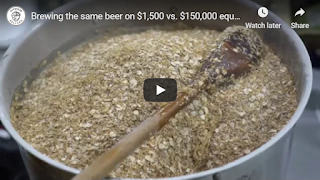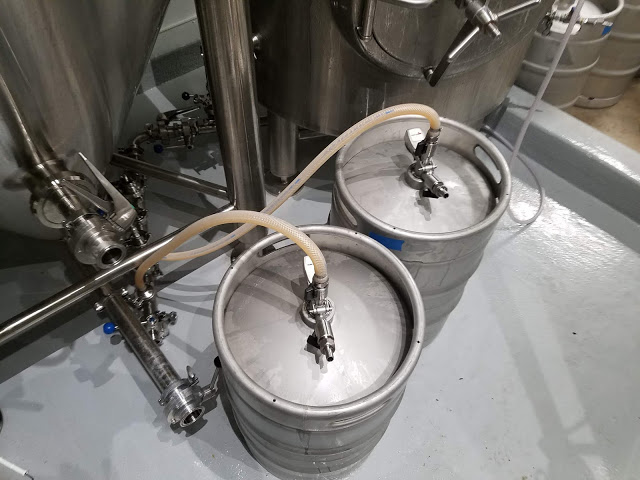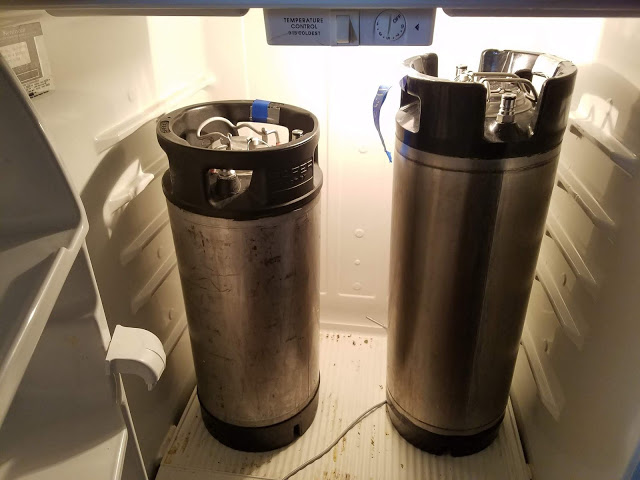Feral’s new Shooter’s Juicy IPA is shaping up as their biggest limited release ever.
The post Feral Brewing’s Shooter’s Juicy IPA is here! appeared first on Beer & Brewer.
Feral’s new Shooter’s Juicy IPA is shaping up as their biggest limited release ever.
The post Feral Brewing’s Shooter’s Juicy IPA is here! appeared first on Beer & Brewer.
Brewery release hoppiest canned beer to date in tribute to installing solar panels.
The post Colonial Brewing make beer from sunshine appeared first on Beer & Brewer.
Canberra brewery create a new sour to celebrate forthcoming art exhibition.
The post Capital Pucker Up with new love potion appeared first on Beer & Brewer.
Solve all of yours (and your dog’s) holiday shopping needs with Stable Craft’s Holiday Gift Cards Central Virginia’s Stable Craft Brewing at Hermitage Hill, an authentic working farm brewery and winery, is making holiday shopping safer and more seamless this season, with the offering of its Stable Craft Holiday Gift cards. In addition to being the perfect […]
The post Stable Craft Brewing’s 2020 Holiday Gift Guide For You And Your Four-Legged BFF appeared first on CraftBeer.com.
The holidays are an opportunity to combine your favorite beer styles with your favorite foods. Here is some simple holiday beer pairing advice.
The post Simple Holiday Beer and Food Pairings appeared first on CraftBeer.com.
The Virginia Beer Company (Williamsburg, VA) will mark the holiday season with the return of their seasonal Spiced Milk Stout, Evil Santa. “Since the first winter we were open back in 2016, Evil Santa has been one of our most sought after recipes,” reminisces Co-Founder Robby Willey. “The branding is playful, the time of year […]
The post Virginia Beer Co. Releases Four Evil Santa Spiced Milk Stout Variants appeared first on CraftBeer.com.
The #1 winter seasonal beer1 returns with a crisper and brighter recipe and festive inspiration for holidays spent at home BOSTON, MA, Nov. 9, 2020—Samuel Adams brewers recognize the winter season will feel different this year, with many Americans taking “home for the holidays” literally. To spread some holiday cheer when drinkers need it most, […]
The post Samuel Adams’ New Winter Lager Brings A Wintery Remix To Holiday Classics appeared first on CraftBeer.com.
272 medals awarded to 240 breweries in world’s most prestigious professional beer competition Boulder, Colo. • October 16, 2020 — The Brewers Association (BA) awarded 272 medals* to 240 breweries across the country during the 2020 Great American Beer Festival (GABF) competition awards ceremony. The best beers in 91 beer categories covering 170 different beer styles (including all subcategories) were awarded gold, silver, and bronze medals during a virtual ceremony hosted on The Brewing Network. Judges for the 34th edition of […]
The post Winners of 2020 Great American Beer Festival Competition Revealed During First-Ever Virtual Ceremony appeared first on CraftBeer.com.
Fretboard Brewing Company (Blue Ash, OH) isn’t known for their collaborations with other breweries. Over the course of their 3 year history, they’ve partnered with musicians like Bootsy Collins and The Cliftones, to foundations like ArtsWave, and even a bread company (Klosterman Baking), but they’ve never released a product brewed in partnership with another brewery. […]
The post Fretboard Brewing and Branch & Bone Artisan Ales team up for “Dark Throne” Collaboration appeared first on CraftBeer.com.
Fall is in the air and that means one thing: harvest season! Brewing with fresh hops is a meticulous process, having to rely on bountiful bines and timing of wet hops plucked, packaged, and shipped overnight via air freight to align with a brew day built around the arrival of those hops and those hops alone…and this […]
The post Virginia Beer Co. Celebrates Harvest Season With Two Wet-Hopped Recipes appeared first on CraftBeer.com.
World’s Fastest Pumpkin Carver Attempts New Guinness World Record, Pumpkin Drop, Grab the Oktoberfest Glass, Socially Distanced Stein Hoist and Many More Fun Fall Festivities WAYNESBORO, VA – (October 5, 2020) – Central Virginia’s Stable Craft Brewery at Hermitage Hill, an authentic working farm brewery and winery, offers the perfect venue and party to celebrate […]
The post Experience Virginia’s Fall Foliage At Stable Craft Brewing’s Fall Harvest Party On Saturday October 17 appeared first on CraftBeer.com.
Introducing: All The Stops – A Virtual Road Trip If 2020 were like any other year, we’d be revving up for ALL THE HOPS, our GABF parking lot can jam extravaganza, where we bring some of the country’s best breweries to Denver for all to enjoy. But this year isn’t like any other. No GABF. […]
The post All The Stops: A Virtual Road Trip appeared first on CraftBeer.com.
OREGON CITY, Ore.––Sept. 29, 2020––While 2020 has led to closures and downsizing for many small businesses, Coin Toss Brewing is thrilled to announce an expansion. The Oregon City brewery and taproom, located at 14214 Fir St., Unit H, is taking over an adjacent suite in its building complex. The new space is approximately 1,500 square […]
The post Coin Toss Brewing Defies the Pandemic Odds, Announces Expansion of its Oregon City Brewery and Taproom appeared first on CraftBeer.com.
 I’m happy to announce the official release of the BeerSmith 3.1 update. This update includes some significant updates to the BeerSmith data storage model, TILT data import, new brewing features and a large number of bug fixes. This release is also a very important foundational step towards establishing both an online version of BeerSmith and […]
I’m happy to announce the official release of the BeerSmith 3.1 update. This update includes some significant updates to the BeerSmith data storage model, TILT data import, new brewing features and a large number of bug fixes. This release is also a very important foundational step towards establishing both an online version of BeerSmith and […]  Buy BeerSmith 3 Download BeerSmith 3 Here is a summary of the new features coming in the BeerSmith 3.1 desktop update. I have posted the open beta version on the main download page at BeerSmith.com, and plan to publish the formal release in the next week or two. You can find additional details for all […]
Buy BeerSmith 3 Download BeerSmith 3 Here is a summary of the new features coming in the BeerSmith 3.1 desktop update. I have posted the open beta version on the main download page at BeerSmith.com, and plan to publish the formal release in the next week or two. You can find additional details for all […]  Gary Glass joins me this week to discuss the state of US Craft and Homebrewing, the upcoming virtual Homebrewcon and some of his own homebrew creations. Subscribe on iTunes to Audio version or Video version or Spotify or Google Play Download the MP3 File– Right Click and Save As to download this mp3 file. Your […]
Gary Glass joins me this week to discuss the state of US Craft and Homebrewing, the upcoming virtual Homebrewcon and some of his own homebrew creations. Subscribe on iTunes to Audio version or Video version or Spotify or Google Play Download the MP3 File– Right Click and Save As to download this mp3 file. Your […]  Denny Conn and Drew Beechum join me this week to discuss hop techniques and brewing beers with unusual specialty ingredients. Subscribe on iTunes to Audio version or Video version or Spotify or Google Play Download the MP3 File– Right Click and Save As to download this mp3 file. Your browser does not support the audio […]
Denny Conn and Drew Beechum join me this week to discuss hop techniques and brewing beers with unusual specialty ingredients. Subscribe on iTunes to Audio version or Video version or Spotify or Google Play Download the MP3 File– Right Click and Save As to download this mp3 file. Your browser does not support the audio […]  Steve Piatz, the author of “The Complete Guide to Making Mead” joins me this week to discuss mead making techniques. Subscribe on iTunes to Audio version or Video version or Spotify or Google Play Download the MP3 File– Right Click and Save As to download this mp3 file. Your browser does not support the audio […]
Steve Piatz, the author of “The Complete Guide to Making Mead” joins me this week to discuss mead making techniques. Subscribe on iTunes to Audio version or Video version or Spotify or Google Play Download the MP3 File– Right Click and Save As to download this mp3 file. Your browser does not support the audio […]  Dr Charlie Bamforth, Professor Emeritus from the University of California at Davis joins me this week to discuss beer brewing yeast. Subscribe on iTunes to Audio version or Video version or on Google Play Download the MP3 File– Right Click and Save As to download this mp3 file. Your browser does not support the audio […]
Dr Charlie Bamforth, Professor Emeritus from the University of California at Davis joins me this week to discuss beer brewing yeast. Subscribe on iTunes to Audio version or Video version or on Google Play Download the MP3 File– Right Click and Save As to download this mp3 file. Your browser does not support the audio […]  Ted Fleming joins me this week from Partake Brewing to discuss how to brew alcohol free beer at home. Subscribe on iTunes to Audio version or Video version or on Google Play Download the MP3 File– Right Click and Save As to download this mp3 file. Your browser does not support the audio element. Topics […]
Ted Fleming joins me this week from Partake Brewing to discuss how to brew alcohol free beer at home. Subscribe on iTunes to Audio version or Video version or on Google Play Download the MP3 File– Right Click and Save As to download this mp3 file. Your browser does not support the audio element. Topics […]  Ron Pattinson joins me to discuss his upcoming book on British beer brewing during World War II. Ron has done extensive research on how commercial beer production and recipes evolved during the war. Subscribe on iTunes to Audio version or Video version or on Google Play Download the MP3 File– Right Click and Save As […]
Ron Pattinson joins me to discuss his upcoming book on British beer brewing during World War II. Ron has done extensive research on how commercial beer production and recipes evolved during the war. Subscribe on iTunes to Audio version or Video version or on Google Play Download the MP3 File– Right Click and Save As […]  Chris White joins me this week to discuss how White Labs produces yeast for commercial brewers and home brewing. We discuss everything from his yeast bank to production and packaging. Subscribe on iTunes to Audio version or Video version or on Google Play Download the MP3 File– Right Click and Save As to download this […]
Chris White joins me this week to discuss how White Labs produces yeast for commercial brewers and home brewing. We discuss everything from his yeast bank to production and packaging. Subscribe on iTunes to Audio version or Video version or on Google Play Download the MP3 File– Right Click and Save As to download this […] 

Calcium | Chloride | Sulfate | Sodium | Magnesium | Carbonate |
120 | 150 | 100 | 20 | 5 | 100 |
Calcium | Chloride | Sulfate | Sodium | Magnesium | Carbonate |
150 | 150 | 150 | 15 | 10 | 90 |

Calcium | Chloride | Sulfate | Sodium | Magnesium | Carbonate |
140 | 170 | 100 | 15 | 10 | 90 |